Spanish Cuisine in Spain
I first tasted Spain the way it’s meant to be tasted—standing, sweating, and a little lost in a side-street bar in Granada. A toothpick jabbed through a chunk of salt cod landed next to my beer. I hadn’t asked for it, didn’t question it, I ate it, and something shifted. The food didn’t whisper. It barked. It didn’t care if I was ready—it was already halfway down my throat. Spanish cuisine in Spain isn’t a curated dining experience—it’s survival with seasoning, ritual with smoke, pride served hot or cold depending on the region. It’s not built to impress you. It’s built to feed you like you belong—or don’t.
Spanish food, when done right, isn’t charming. It’s blunt, it’s fast, and it’s old. Spanish cuisine in Spain isn’t a menu—it’s a way of dealing with life, hunger, and time.
This isn’t about cuisine. It’s about character.
Tapas: Designed to Keep You Drinking
Tapas aren’t small plates for tasting. They’re strategic. They’re how Spain keeps you on your feet, in the bar, and buying drinks long after your plans fell apart. The first tapa is bait. The second is your welcome. By the third, you’re part of the neighborhood. It’s the most casual—but deeply embedded—expression of Spanish cuisine in Spain you’ll encounter.
You don’t order tapas like you order dinner. You earn them—one drink at a time.
Understand the rules:
- Caña (small beer) = free tapa in many Andalusian cities (Granada, Jaén, Almería)
- You don’t ask what’s coming. It shows up. You eat it.
- You move from bar to bar. One drink, one plate, move on. It’s a crawl with snacks.
The real players:
- Tortilla Española – golden, thick, and if it’s done right, creamy in the middle
- Pimientos de Padrón – mild… until one tries to kill you
- Boquerones en vinagre – anchovies in vinegar and garlic; salty, sharp, addictive
- Chorizo al vino – sausage poached in red wine, fat glistening
- Croquetas – ham, mushroom, or mystery—deep-fried béchamel bombs
The point isn’t full. The point is forever not quite full. And always just one more drink.

Paella: You’ve Been Lied To
Paella is the most abused dish in Spain. It’s been paraded around tourist menus, loaded with frozen shrimp and peas, and bastardized beyond recognition. But in Valencia, it’s still made the right way: over open flame, in a pan the size of a car tire, by someone who doesn’t care if you’re impressed.
You don’t order paella – you wait for it, respect the rice, and you eat it at lunch and walk it off with pride.
Real deal rules:
- Paella Valenciana – made with rabbit, chicken, flat beans, sometimes snails
- Cooked over wood—not gas, not a stove
- Never stirred once the rice goes in. Disturb the crust, and you deserve the soggy mush you get.
Those are all red flags. If you’re after Spanish cuisine in Spain, you should be chasing rice cooked slowly, served locally, and protected like family legacy.
Don’t trust a menu that:
- Arroz negro – squid ink black rice with cuttlefish
- Fideuà – Valencian cousin using short noodles instead of rice
- Socarrat – crispy layer of rice at the bottom: fight for it
- Offers paella at night
- Lists it next to pizza or nachos
- Promises it “ready in 10 minutes”
Better options:
Paella done right is simple, quiet, and devastating. No lemon slices. No theatrics. Just rice and fire.
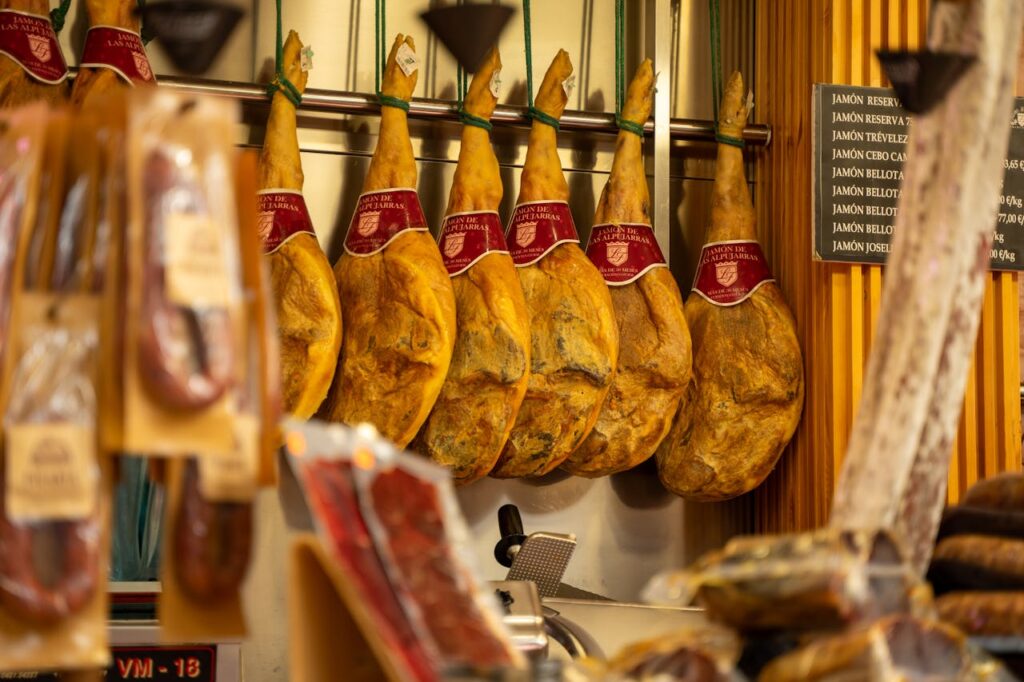
Jamón Ibérico: Spain’s Cured Religion
Walk into any decent Spanish bar, and the legs of pigs hang like trophies—hooves and all. They’re not decoration. They’re the house pride. Spain doesn’t just eat ham. It worships it. It’s one of the most iconic elements of Spanish cuisine in Spain, and still treated like a sacred act of patience.
And no, this isn’t your sliced sandwich filler. This is meat that’s aged longer than your last relationship.
Here’s the hierarchy:
- Jamón serrano – basic, everyday, still better than 90% of ham worldwide
- Jamón ibérico – darker, fattier, nuttier from black Iberian pigs
- Jamón ibérico de bellota – top-tier pigs fed exclusively on acorns; think silk and smoke in meat form
How to consume like a local:
- Let it warm—fat should glisten, not chill
- Eat with your fingers—respect it, don’t overhandle it
- Pair it with fino sherry or a dry red from Ribera del Duero
If the bar has a man in the corner carving paper-thin slices by hand, you sit. You shut up. You eat.
Cheese in Spain: Rough, Raw, Real
Spanish cheese doesn’t beg for attention. It just sits there, quietly excellent, waiting to be noticed by people who know better. There are no marketing campaigns. No French attitude. Just time, salt, and animal instinct.
Top hitters:
- Manchego – aged sheep’s milk; nutty, firm, trustworthy
- Cabrales – cave-aged blue cheese; aggressive, unapologetic
- Torta del Casar – runny sheep cheese from Extremadura; spoon it, smear it, respect it
- Mahon – cow’s milk cheese from Menorca; salty, tangy, wildly underrated
Best with:
- Quince paste (membrillo) + Manchego
- Raw honey + Torta del Casar
- Sidra + Cabrales (makes you feel alive)
There’s no shame in cheese here. Just depth and age and quiet power.
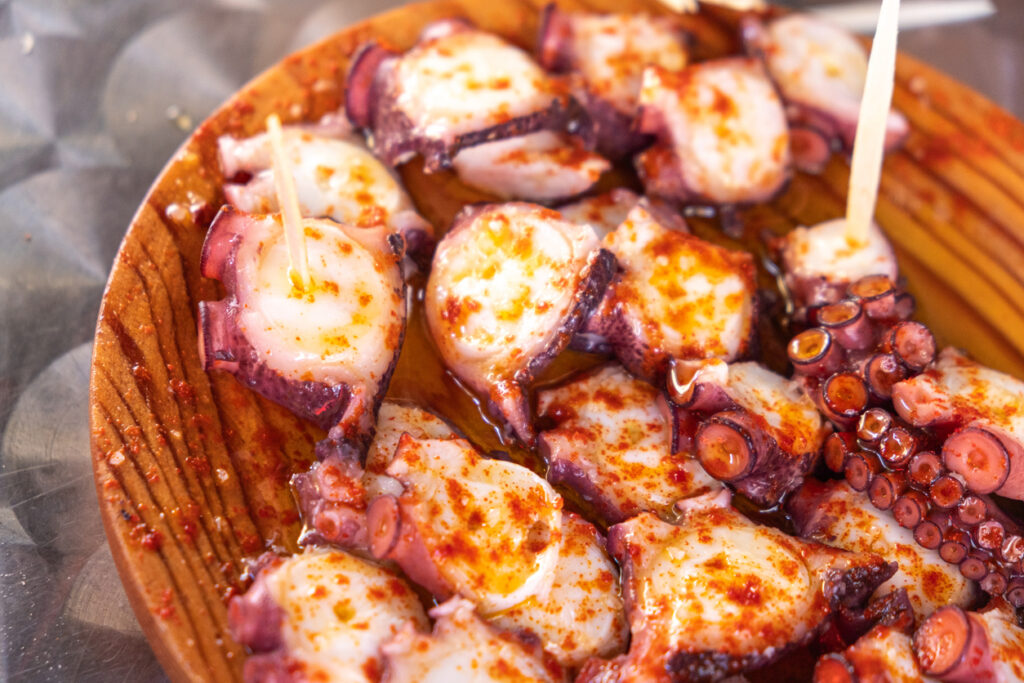
Seafood: Brutal, Fresh, and Staring at You
In Spain, seafood is served like it was fished five minutes ago—because sometimes it was. This isn’t delicate. It’s raw, honest, and sometimes still twitching.
What to hunt down:
- Pulpo a la gallega – octopus on sliced potatoes, paprika, and oil; chewy, rich, elemental
- Sardinas a la brasa – skewered sardines grilled on open flames in beach sand
- Gambas al ajillo – shrimp in garlic oil; served sizzling, scalds optional
- Tigres – stuffed mussels with béchamel and breadcrumb armor
- Percebes – goose barnacles that look like dinosaur toes; cost a fortune, worth every cent
Where to eat it:
- Galicia – where seafood is religion
- Asturias – where cider is drunk with every shellfish
- Madrid – landlocked, yet paradoxically obsessed with fish, thanks to logistics and legacy
Expect bones., expect eyes, expect flavor. This is how Spanish cuisine in Spain honors the sea—with zero frills, zero fear, and maximum taste.
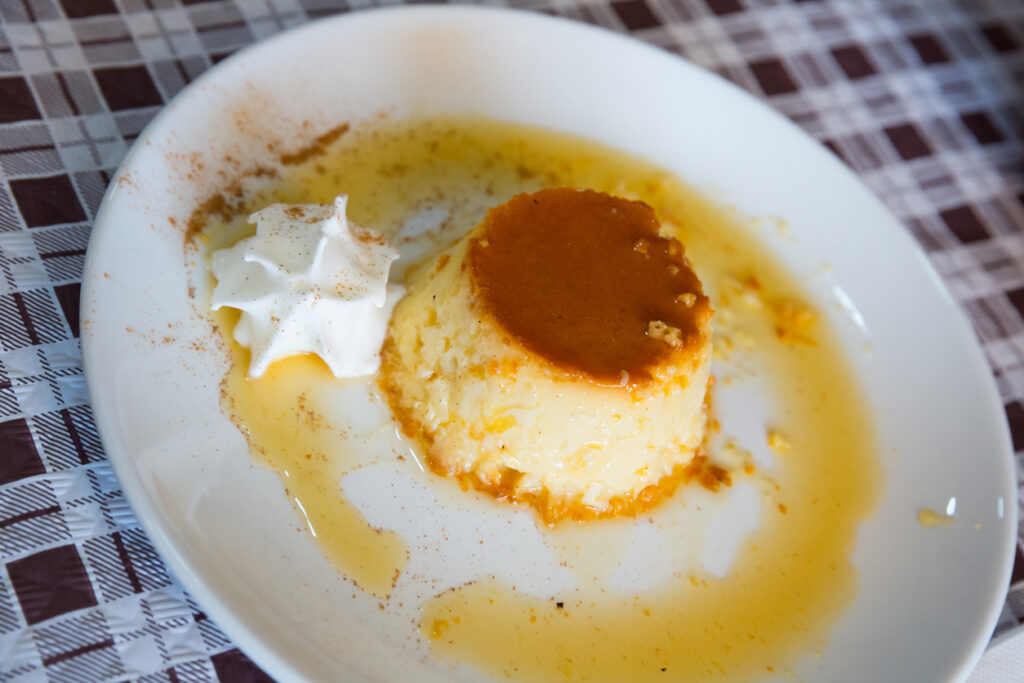
Desserts: No Flash, All Finish
Spain doesn’t believe in dessert as spectacle. It’s the smoke break after the main event. Sweet, quiet, grounding. It rarely shows off—but it almost always delivers.
The classics:
- Flan – wobbly, caramel-topped custard; everywhere, always good
- Tarta de Santiago – almond cake with a holy cross; Galician, monastic, subtle
- Churros con chocolate – fried dough, hot and unsweetened; served with molten chocolate thicker than regret
- Crema catalana – crème brûlée’s rougher, citrusy cousin
How to finish a meal:
- One of these + café solo (espresso) or licor de hierbas
- No “dessert menus” in real places—just ask what’s left
- If they have queso con membrillo, take it. You win.
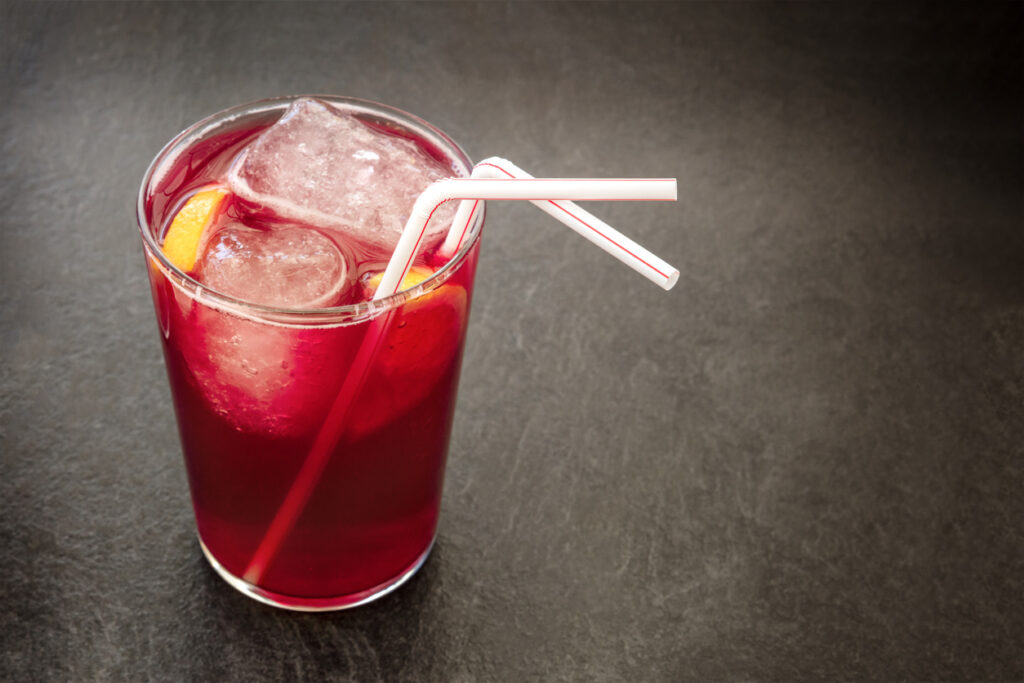
Drinks: Not Fancy. Just Constant.
In Spain, drinks don’t need a reason. Or a glass.
They appear when the moment’s right—and in Spain, the moment’s always right.
Daily rhythm of drinking:
- Coffee (multiple times, and never to-go)
- Beer with lunch; caña is the size you want
- Vermut around 1–2 p.m., on tap, sweet and spiced
- Wine all day long—red, white, cheap, cold
- Orujo or hierbas after dinner, depending on how brave you feel
Region-specific sips:
- Tinto de verano in Madrid (not sangria, unless you’re 19)
- Sidra natural in Asturias—sour, funky, poured from high
- Fino sherry in Andalusia—dry, salty, strong as hell
- Cava in Catalonia—better than Champagne, and they know it
Don’t ask what to drink. Ask what the old guy at the bar is drinking. Then do that.
Looking to Plan Your Stay?
If you’re serious about eating your way through Spain, don’t just book a place to sleep—book a place to eat nearby. Planning a trip to dive deep into Spanish cuisine in Spain means choosing cities and hotels by what’s nearby—markets, bodegas, family-run joints. Stay where the market opens early, the bars open late, and the street noise is the right kind of chaotic.
Use the interactive map below to explore local hotels, guesthouses, or that one rental above a jamón shop you won’t forget.
👉 Use This Map to Book Your Hotel Now
(Or don’t. But don’t say no one gave you the good spots.)
The Real Regions That Feed You
If you still think “Spanish food” is a unified thing, you’re not paying attention. Spanish cuisine in Spain changes drastically every 200 kilometers, and every cook thinks their version is the truth. Every region has its own voice. And it’s yelling. Loudly. With pride, salt, smoke, and zero apologies.
Andalusia
Hot sun, cold soup, fried everything. Tapas rule. Gazpacho flows. Life slows to chew.
Salmorejo
- How to order: At lunch, ask for “un salmorejo bien frío.”
- How to eat: Scoop it up with bread, don’t drink it. The jamón and chopped egg on top? Stir them in.
- Pair with: A cold caña or a crisp manzanilla sherry.
Pescaíto frito
- How to order: Just say “una ración de pescaíto frito.” They’ll bring a mix—don’t overthink it.
- How to eat: With your fingers. Watch the bones. Eat the skin. Maybe the heads. Maybe not.
- Pair with: Ice-cold beer or a glass of fino.
Tortillitas de camarones
- How to order: If it’s on the menu, you’re lucky. If not, ask. “¿Tienen tortillitas hoy?”
- How to eat: Grab one and bite in. Crispy, shrimpy, salty. No sauce needed.
- Pair with: Anything dry and cold. Andalusian white wine or vermut.
Basque Country
Michelin stars meet grandma’s pantry. Pintxos that belong in galleries. Cod gets the red-carpet treatment.
Bacalao al pil-pil
- How to order: This is a sit-down dish. Look for it on chalkboard menus in classic taverns.
- How to eat: Don’t destroy the sauce—it’s a garlic-oil emulsion that took time. Spoon it, respect it.
- Pair with: Txakoli (dry Basque white wine) or sidra.
Txangurro
- How to order: Pronounce it “CHAN-goo-roh” and ask for it baked. They’ll know.
- How to eat: Comes hot, in a crab shell. Dig in with a spoon.
- Pair with: Chilled Albariño or Basque cider.
Pintxos
- How to order: Walk the bar. Point. Don’t overtalk. Grab a plate and build your own stack.
- How to eat: Two bites, max. Napkin in hand. Toothpick goes in the jar after.
- Pair with: Beer, wine, vermut—anything small. You’re moving soon.
Catalonia
Earthy. Proud. Slightly offbeat. Sweet mixes with savory. Meals have roots.
Escalivada
- How to order: As a starter or on top of toast—“una tostada con escalivada.”
- How to eat: Room temp, with anchovies or goat cheese if you’re lucky.
- Pair with: Cava or a glass of vermut.
Calçots con romesco (seasonal)
- How to order: February to April, look for “calçotadas.” It’s an event. Bib included.
- How to eat: Strip the char, dip in romesco, tilt your head, inhale like a savage.
- Pair with: Rustic red wine in a porró. Expect to spill.
Butifarra
- How to order: Ask for “butifarra amb mongetes” for the full Catalan experience.
- How to eat: Knife and fork. Beans soaked in the sausage fat are the main event.
- Pair with: Light red wine or dark beer.
Valencia
Rice territory. Obsessive, opinionated, unmatched.
Paella Valenciana
- How to order: Call ahead. Good paella isn’t spontaneous. Always for two or more.
- How to eat: Don’t mix. Scrape gently to get the socarrat. No lemon. Ever.
- Pair with: Dry white or rosado. Or beer. You’ll need it.
Arroz al horno
- How to order: Only locals order this. Say “una ración de arroz al horno, por favor.”
- How to eat: Served in clay. Let it cool slightly. Let the flavor hit.
- Pair with: Red wine with backbone—this dish has weight.
Fideuà
- How to order: “Fideuà de marisco” (seafood). Avoid tourist joints. Ask locals.
- How to eat: Like paella—no stirring, no fluff. Squeeze lemon if you must.
- Pair with: Cava or a sharp white.
Galicia
Sea. Stone. Salt. You eat what the tide brings in.
Pulpo a la gallega
- How to order: “Un pulpo, por favor.” Or better—just go to a pulpería.
- How to eat: On wooden plates, over potatoes. Fork only. Paprika everywhere.
- Pair with: Albariño, poured cold. Like the Atlantic in a glass.
Empanadas gallegas
- How to order: Find a bakery. Ask “¿Qué empanadas tienen hoy?”
- How to eat: Room temp. Tuna and pepper is the classic. Crust should flake.
- Pair with: Local beer or cider.
Percebes
- How to order: Be brave. “Una ración de percebes.” Prepare your wallet.
- How to eat: Snap the neck, suck out the meat. Ignore the visuals.
- Pair with: More Albariño. Trust the sea.
Castile and León
Heavy. Meaty. Unapologetic. Home of roast everything.
Lechazo
- How to order: Call ahead. This is roast lamb—meant to be slow. Meant to be shared.
- How to eat: Fork and knife, but with urgency. Skin cracks like glass.
- Pair with: Ribera del Duero red. Nothing else.
Morcilla de Burgos
- How to order: “Una tapa de morcilla.” Sometimes with rice. Always with intensity.
- How to eat: Crispy edges, soft inside. Spread on bread if needed.
- Pair with: Red wine or sidra if you’re feeling rustic.
Cochinillo
- How to order: Same rules as lechazo. This is celebration food. Reserve it.
- How to eat: Crunch the skin. Don’t overthink it. The fat is the feature.
- Pair with: Tempranillo, aged.
Madrid
The melting pot. A little of everything, with guts.
Cocido madrileño
- How to order: Set menu, often on Tuesdays. Served in three acts: soup, chickpeas/veg, then meat.
- How to eat: Clear your afternoon. This isn’t lunch. It’s war.
- Pair with: Rioja or beer. And water. Lots of water.
Callos
- How to order: “Una tapa de callos, si tienen.” Not everywhere serves it anymore.
- How to eat: Go slow. Rich, spicy, gelatinous. Know what you’re getting into.
- Pair with: Red wine, deep and bold.
Bocadillo de calamares
- How to order: Walk to Plaza Mayor. Say nothing. Point. Pay. Eat.
- How to eat: Fried squid, white bread, no sauce. Just bite and chew.
- Pair with: Beer. Standing. Always.
Conclusion: Eat Like It Matters
Spanish cuisine in Spain isn’t built for Instagram. It’s built to keep people fed, full, and talking. Don’t come to Spain for the picture. Come for the ritual. Come for the guy behind the counter who’s made the same dish every day for 30 years and doesn’t care about your Yelp review.
This isn’t food to impress. It’s food to live by.
So sit down. Shut up. Order the thing you don’t recognize.
And when it shows up—eat it like you mean it.
FAQ’s
What is typical Spanish food in Spain?
Typical Spanish food in Spain is deeply regional but always built around a few constants: olive oil, fresh ingredients, and slow traditions. Staples include tapas (small bar snacks like tortilla Española or boquerones), jamón ibérico (cured ham), paella Valenciana, and stews like cocido madrileño. Spain doesn’t do overly complicated—it does simple done right, often with garlic, salt, and fire.
What is the cultural cuisine of Spain?
Spain’s cultural cuisine is a mosaic of local identities rooted in geography, history, and ritual. It’s not one cuisine—it’s many. From seafood-heavy dishes in Galicia, to rice-based meals in Valencia, to bold, fried traditions in Andalusia, Spanish food is regional and fiercely loyal to its roots. Meals are social, long, and often shared. Eating is not an event. It’s a way of life.
What is the national dish of Spain in Spanish?
The national dish of Spain is widely considered to be paella, known in Spanish as “la paella” or “paella Valenciana” when referring to the original version. This dish comes from Valencia and features rice, rabbit, chicken, and green beans cooked in a wide, shallow pan over an open flame. Despite its global fame, true paella is a regional dish done locally and with rules.
What is Spain’s special dish?
Spain’s most iconic and special dish is jamón ibérico de bellota—cured ham from acorn-fed Iberian pigs. Aged for years and sliced by hand, it’s prized for its deep, nutty flavor and melt-in-your-mouth texture. Other contenders include paella Valenciana, tortilla Española, and pulpo a la gallega—but if you ask a Spaniard, the answer depends on the region. There is no one dish—there’s pride in all of them.
Spain Packing List
Explore expert-curated guides on the best travel accessories, noise-canceling headphones, essential safety items for solo female travelers, stylish outfit ideas for Spain, and top deals on travel gear in 2025, ensuring a seamless and well-prepared journey.
The Best Noise Cancelling Headphones for Airplane Travel
Find the best noise-canceling headphones for airplane travel, offering superior comfort, sound quality, and battery life for a peaceful journey.
The Essential Safety Items for Solo Female Travelers
Discover the essential safety items for solo female travelers to stay secure, confident, and prepared on any journey.
The Ultimate Guide to the Best Travel Accessories in 2025
Explore the ultimate guide to the best travel accessories in 2025, featuring must-have gadgets and gear for a seamless and comfortable trip.
Essential Travel Gadgets for Women: The Must-Have Tools for a Seamless Trip
Discover the essential travel gadgets for women, featuring must-have tools to enhance convenience, security, and comfort for a seamless trip.
Prime Big Deal Days: The Best Travel Gear and Deals for 2024
Discover the best travel gear and deals for 2024 during Prime Big Deal Days, featuring top discounts on must-have essentials for your next trip.

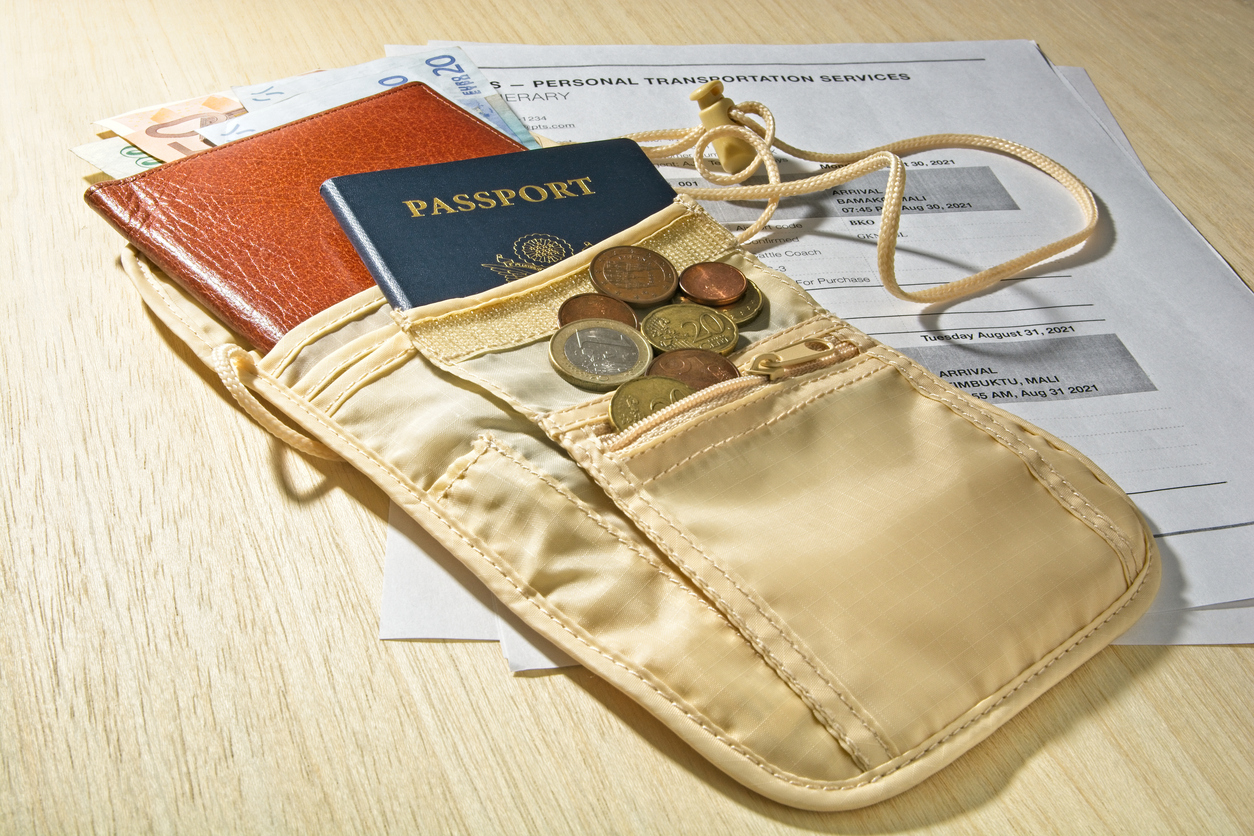


Be the first to comment